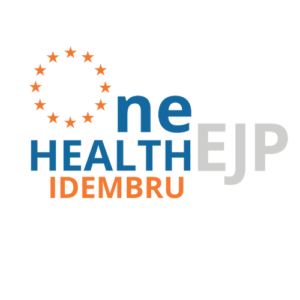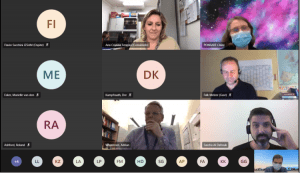Houtribweg 39, Lelystad, Flevoland, The Netherlands
Südufer 10, Greifswald, Mecklenburg-Vorpommern, Germany
Max-Dohrn-Straße 8, Berlin, Berlin, Germany
Addlestone, England, United Kingdom
Teramo, Abruzzo, Italy
Rua Rio Ave 1600, Carnide, Área Metropolitana de Lisboa, Portugal
Avenida da República, Oeiras e São Julião da Barra, Paço de Arcos e Caxias, Área Metropolitana de Lisboa, Portugal
Boulevard "Maritza" 86
Plovdiv
Plovdiv Province
4000
14 Rue Pierre et Marie Curie, Maisons-Alfort, Île-de-France, France

The Project #IDEMBRU
| Start: | 1 January 2020 |
| Duration: | 2.5 Years |
| Domain: | Emerging Threats |
| Keywords: | emerging Brucella, reservoir, virulence, whole genome sequencing, RNA detection |
| Contact: | Claire Ponsart (ANSES) |
IDEMBRU: Identification of emerging Brucella species: new threats for human and animals
Brucellosis is a highly contagious zoonosis usually caused by ingestion of unpasteurised milk or undercooked meat from infected animals, or close contact with their secretions. Brucellosis is one of the most widespread zoonotic diseases globally, with 500,000 new human cases estimated each year. For many years six ‘classical’ Brucella species were identified but, since the late 1990’s, several new Brucella species (including B. inopinata, B. microti and B. vulpis) were isolated from humans, wild animals and/or environmental sources demonstrating a wider range of hosts and new potential zoonotic threats. Some of these species are genetically and/or phenotypically atypical in comparison to the ‘classical’ species.
Brucellosis is a highly contagious zoonosis usually caused by ingestion of unpasteurised milk or undercooked meat from infected animals, or close contact with their secretions. Brucellosis is one of the most widespread zoonotic diseases globally, with 500,000 new human cases estimated each year. For many years six ‘classical’ Brucella species were identified but, since the late 1990’s, several new Brucella species (including B. inopinata, B. microti and B. vulpis) were isolated from humans, wild animals and/or environmental sources demonstrating a wider range of hosts and new potential zoonotic threats. Some of these species are genetically and/or phenotypically atypical in comparison to the ‘classical’ species.
In 2017, European amphibians were reported to be infected by one such recently identified species (B. microti), already reported in rodents, foxes and wild boar, thus confirming the broad host range of emerging atypical Brucella. These emerging Brucella isolates need to be further investigated to evaluate their geographical distribution and host range, to assess their zoonotic potential, and to compare their virulence and persistence markers with classical species.
Other emerging situations concern classical Brucella species, such as Brucella suis and Brucella melitensis, which circulate in wildlife reservoirs with the potential to spillover to domestic animals and humans or which are emerging in Western Europe as a result of pet movements (Brucella canis). Currently only some classical Brucella species are subject to statutory control and surveillance strategies in domestic animals in Europe. Therefore, these species are potentially underdiagnosed in wildlife. Some Brucella species are classified into biovars, and species and biovars vary in terms of pathogenicity for humans. The most studied Brucella species and biovars correspond to those presenting the known highest risk of transmission to humans while others are poorly characterised. Finally, emerging reservoirs of classical Brucella could be linked with new consumption patterns, with developing practices of organic and raw milk products, with imported animal-derived products from different origins or with emerging animal movement pathways
An exhaustive evaluation and understanding of emerging non-classical Brucella and emerging reservoirs of classical species is needed to protect people and animals from infection. The IDEMBRU project aims were to develop a toolbox focusing on emerging Brucella species and reservoirs in order to ensure rapid detection, identification and characterisation.
The project includes:
i) The detection and investigation of these pathogens from different sources under various epidemiological contexts in terms of natural landscape, livestock demographics, and wildlife populations (Mediterranean, East, North and West Europe).
ii) The characterisation of the emerging Brucella species by identification of genomic and phenotypic variability via high throughput methods (NGS, molecular tests, proteomics, metabolomics).
iii) The understanding of virulence and zoonotic potentials through in vivo and in vitro infection models.
iv) The development of a toolkit for the integration of data from emerging Brucella and as a resource to guide characterisation of emerging Brucella.
Project Assets
1. Analyses of samples from different epidemiological contexts and wildlife
This project has tested more than 1500 samples from three distinct bio tops present in Europe and very few Brucella spp. or Ochrobactrum spp. strains have been found. This project evaluated the presence of non-core Brucella in European environment and wildlife. Already isolated strains were used to evaluate existing and develop new molecular practices for DNA isolation, purification, discrimination of Ochrobactrum genus as well as high quality sequencing.
Several new complementary bacteriology analyses have been developed to separate core from non –core strains, and prepared one of the most complete MALDI-TOF spectral databases to identify core, non-core Brucellae spp and Ochrobactrum, that will greatly shorten the diagnostic time and responses to Brucella outbreaks.
Specific virulence- and bio-markers were identified that, in combination with cellular infection results (cytokine and RNA profiles) will be the basis of zoonotic potential characterisation not only for Brucella, but also genetically similar species (Francisella spp. for example).
2. Toolkits
IDEMBRU conceived different toolkits for the integration of data from emerging Brucella (non core Brucella, Brucella canis, Brucella from unexpected hosts) and as a resource to guide characterisation of emerging Brucella.
The IDEMBRU collaboration with PADI Web platform for epidemic surveillance started on early warning systems for Brucella outbreaks in European countries.
Toolkit for non-core Brucellae
- Introduction
- Data collection tools
- Diagnostic strategy
- List of references
Website links will soon be available for all these toolkit components
Toolkit for Brucella canis
- Introduction
- Case definition
- Organise the data collection with tools: Epidemiological questionnaire for canine B. canis caused brucellosis investigations; Questionnaire for the investigation of canine brucellosis in the French kennels; B.canis outbreak data collection.
- Diagnostic strategy
- Management strategy: Outbreak management
- Dissemination documents
- List of references
Website links will soon be available for all these toolkit components
Toolkit for Brucella in non-preferred host (under construction)
PADI WEB based early warning system (under construction)
3. Guidelines and SOPs
IDEMBRU has developed many guidelines and Standard Operating Procedures (SOPs), which have been integrated into 3 main toolkits.
All SOPs are accessible on the ZENODO platform:
WP1.SOP1- Guidelines for sample collection and treatment
WP1.SOP3- Standard Operating procedure for Serological diagnosis
WP1.SOP4- Standard Operating procedure for Bacteriological diagnosis
WP1.SOP5- DNA extraction from soil and faeces
WP2.SOP1- Questionnaire for Brucellosis research
WP4.SOP1- Phenotyping scheme to differentiate emerging Brucella sp. from classical species
WP4.SPO2- AMR testing protocol including proposals for ECOFFs for emerging Brucella sp.
WP5.SOP1- Protocol for Brucella in vitro infection assay
WP5.SOP2- Visualization of intracellular bacteria after infection (IPMA)
WP5.SOP3- Brucella PCR – bcsp31, IS711, per genes
4. Dissemination materials
IDEMBRU collaborated with the OHEJP COHESIVE project to form a working group to evaluate the presence of B. canis in dogs and humans and to determine its pathogenic characteristics.
Together they have worked to prepare a White Paper on B. canis regarding current epidemiological situation in Europe and recommendations to stakeholders for further necessary actions.
IDEMBRU partners organised different webinars in order to raise awareness on canine brucellosis and provided different factsheets focusing on canine brucellosis, translated into different languages.
A main webinar has been organised on December 8th 2022 for the EFSA network of veterinary services and veterinary practitioners on canine brucellosis.
The webinar was provided by the ANSES team for brucellosis and organised as a follow-up of a point 6 of 40th EREN Network meeting. The webinar can be viewed on Vimeo.
There are different factsheets available on Brucella canis in multiple languages targeting some endemic regions in the world. Canine Brucellosis factsheets are available in English, French, Russian and Ukrainian.
Djokic, V., Freddi, L., de Massis, F., Lahti, E., Esker, M. V. D., Whatmore, A., Haughey, A., Ferreira, A. C., Garofolo, G., Melzer, F., Sacchini, F., Koets, A., Wyllie, S., Fontbonne, A., Girault, G., Vicente, A. F., McGiven, J., & Ponsart, C. (2023). The emergence of Brucella canis as a public health threat in Europe: what we know, and what we need to learn. Emerging microbes & infections. 2249126. Advance online publication. DOI: https://doi.org/10.1080/22221751.2023.2249126
Girault, G., Djokic, V., Petot-Bottin, F., Perrot, L., Thibaut, B., Sébastien, H., Vicente, A. F., Ponsart, C., Freddi, L. (2023). Molecular Investigations of Two First Brucella suis Biovar 2 Infections Cases in French Dogs. Pathogens. 12(6), 792. DOI: https://doi.org/10.3390/pathogens12060792
De Massis, F., Sacchini, F., Petrini, A., Bellucci, F., Perilli, M., Garofolo, G., Savini, G., & Tittarelli, M. (2022). Canine brucellosis due to Brucella canis: description of the disease and control measures. Veterinaria Italiana. 58(1), 5–23. DOI: https://doi.org/10.12834/VetIt.2561.16874.1
Occhialini, A., Hofreuter, D., Ufermann, C. M., Al Dahouk, S., & Köhler, S. (2022). The Retrospective on Atypical Brucella Species Leads to Novel Definitions. Microorganisms. 10(4), 813. DOI: https://doi.org/10.3390/microorganisms10040813
De Massis, F., Sacchini, F., Averaimo, D., Garofolo, G., Lecchini, P., Ruocco, L., Lomolino, R., Santucci, U., Sgariglia, E., Crotti, S., Petrini, A., Migliorati, G., D’Alterio, N., Gavaudan, S., & Tittarelli, M. (2021). First Isolation of Brucella canis from a breeding kennel in Italy. Veterinaria Italiana. 57(3). DOI: https://doi.org/10.12834/VetIt.2497.15848.1
Freddi, L., Djokic, V., Petot-Bottin, F., Girault, G., Perrot, L., Ferreira Vicente, A., & Ponsart, C. (2021). The Use of Flocked Swabs with a Protective Medium Increases the Recovery of Live Brucella spp. and DNA Detection. Microbiology spectrum. 9(3), e0072821. DOI: https://doi.org/10.1128/Spectrum.00728-21





